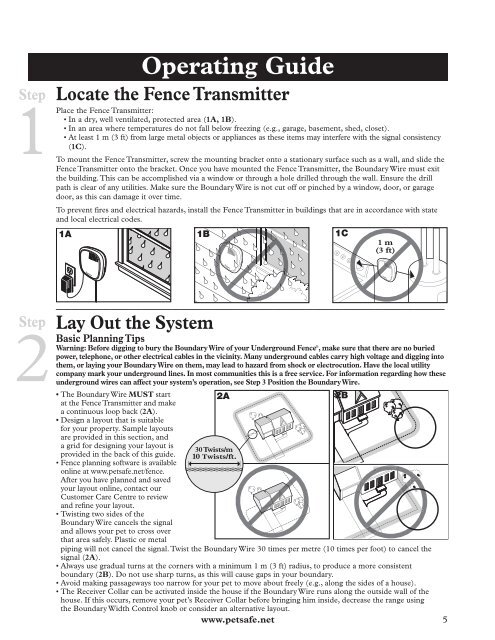Fase - PetSafe Australia
Fase - PetSafe Australia
Fase - PetSafe Australia
Create successful ePaper yourself
Turn your PDF publications into a flip-book with our unique Google optimized e-Paper software.
Step<br />
1<br />
Step<br />
2<br />
Locate the Fence Transmitter<br />
Place the Fence Transmitter:<br />
• In a dry, well ventilated, protected area (1A, 1B).<br />
• In an area where temperatures do not fall below freezing (e.g., garage, basement, shed, closet).<br />
• At least 1 m (3 ft) from large metal objects or appliances as these items may interfere with the signal consistency<br />
(1C).<br />
To mount the Fence Transmitter, screw the mounting bracket onto a stationary surface such as a wall, and slide the<br />
Fence Transmitter onto the bracket. Once you have mounted the Fence Transmitter, the Boundary Wire must exit<br />
the building. This can be accomplished via a window or through a hole drilled through the wall. Ensure the drill<br />
path is clear of any utilities. Make sure the Boundary Wire is not cut off or pinched by a window, door, or garage<br />
door, as this can damage it over time.<br />
To prevent fi res and electrical hazards, install the Fence Transmitter in buildings that are in accordance with state<br />
and local electrical codes.<br />
1A 1B<br />
Operating Guide<br />
1C<br />
1 m<br />
(3 ft)<br />
__________________________________________________<br />
Lay Out the System<br />
Basic Planning Tips<br />
Warning: Before digging to bury the Boundary Wire of your Underground Fence ® , make sure that there are no buried<br />
power, telephone, or other electrical cables in the vicinity. Many underground cables carry high voltage and digging into<br />
them, or laying your Boundary Wire on them, may lead to hazard from shock or electrocution. Have the local utility<br />
company mark your underground lines. In most communities this is a free service. For information regarding how these<br />
underground wires can affect your system’s operation, see Step 3 Position the Boundary Wire.<br />
• The Boundary Wire MUST start<br />
at the Fence Transmitter and make<br />
a continuous loop back (2A).<br />
• Design a layout that is suitable<br />
for your property. Sample layouts<br />
are provided in this section, and<br />
2A 2B<br />
a grid for designing your layout is<br />
provided in the back of this guide.<br />
• Fence planning software is available<br />
online at www.petsafe.net/fence.<br />
After you have planned and saved<br />
your layout online, contact our<br />
Customer Care Centre to review<br />
and refi ne your layout.<br />
• Twisting two sides of the<br />
Boundary Wire cancels the signal<br />
and allows your pet to cross over<br />
that area safely. Plastic or metal<br />
30 Twists/m<br />
10 Twists/ft.<br />
piping will not cancel the signal. Twist the Boundary Wire 30 times per metre (10 times per foot) to cancel the<br />
signal (2A).<br />
• Always use gradual turns at the corners with a minimum 1 m (3 ft) radius, to produce a more consistent<br />
boundary (2B). Do not use sharp turns, as this will cause gaps in your boundary.<br />
• Avoid making passageways too narrow for your pet to move about freely (e.g., along the sides of a house).<br />
• The Receiver Collar can be activated inside the house if the Boundary Wire runs along the outside wall of the<br />
house. If this occurs, remove your pet’s Receiver Collar before bringing him inside, decrease the range using<br />
the Boundary Width Control knob or consider an alternative layout.<br />
www.petsafe.net 5


